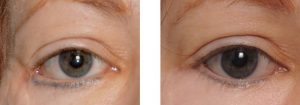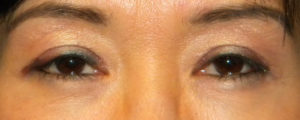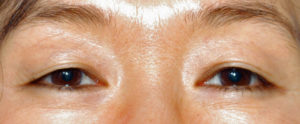The eyelids are a small facial area that has a big impact on our appearance. Slight changes in eyelid position can make for a surprising difference in appearance. While many think of the eyelids as just skin, there are chalked full of small anatomic pieces that make them both work and look normal. One of these hidden features is how the eyelids are suspended to the bone. With some tendons at the inside and outside of the eye, the lids are suspended like a clothesline from one corner to another.
This is particularly true of the lower eyelid which must be held up and tucked in closely to the eyeball at a level just at the lower edge of the pupil. The outer corner of the eye and the tendon that holds it at its position (lateral canthus) The tendons of the upper and lower eyelids travel along beneath the eyelashes and come together in a common tendon on the side that connects to the bone of the eye socket. If this tendon gets loose or is connected too low, the corner of the eye will turn down making one look sad or tired. Some people have this tendon position naturally, others have it develop with age. A few others have it happen after lower eyelid (blepharoplasty) surgery as the pull of the scar combined with a weak or loose tendon alter the position of the corner of the eye.
There is a very specific technique to tighten, elevate, and/or reconnect this tendon at the bony edge of the eye socket.This known in plastic surgery as either a canthoplasty and canthopexy. Its use is always associated with surgery on the lower eyelids. Although these two eye tendon terms are often used as if they were the same, canthoplasty and canthopexy are different tendon operations. Canthoplasty involves either reattaching (if detached) or changing the position of the lateral canthal tendon and its attached muscle from the bone at the side of the eye socket. It is usually being moved to a higher position on the bone. Canthopexy is about tightening the same tendon and muscle without detaching or reconstructing the tendon. The objective of both is to correct a sagging lower eyelid. These tendon operations can be done at the same time as a lower blepharoplasty or separately depending upon the eyelid problem.


Dr. Barry Eppley
Indianapolis, Indiana



